Modeling Climate Characteristics of Qinghai Lake Ice in 1979–2017 by a Quasi-Steady Model
Abstract
:1. Introduction
2. Research Region, Data, and Models
2.1. Research Region
2.2. Data
2.2.1. Lake Ice Heat Conductivity
2.2.2. Lake Ice Thickness from Airborne Radar
2.2.3. Lake Ice Thickness from the Xiashe Hydrologic Station
2.2.4. Gangcha Meteorological Station Data
2.2.5. Meteorological Elements Gradient of Yulei Station on the Qinghai Lake
2.2.6. Terra/MODIS Remote Sensing Images
2.2.7. China Meteorological Forcing Dataset (1979−2018)
2.2.8. Daily Lake Ice Extent and Coverage Dataset for the TP
2.3. Models and Methods
2.3.1. The Quasi-Steady Lake Ice Model
2.3.2. Correlation Analysis and Detrending Analysis
3. Results
3.1. Thermal Conductivity Observation Result
3.2. Modeled Qinghai Lake
3.2.1. Lake Ice in 2018–2019
3.2.2. Long-term Climatic Characteristics in 1979–2017
Ice Thickness
Ice Phenology
3.3. Correlation Analysis and Detrending Analysis
3.3.1. Correlation Analysis
Air Temperature
Downward Longwave Radiation
Wind Speed
Solar Radiation
3.3.2. Detrending Analysis
4. Discussion
4.1. Lake Ice Evolution in Other Regions
4.2. More Information on the Leppäranta Model
5. Conclusions
Author Contributions
Funding
Data Availability Statement
Conflicts of Interest
References
- Zhang, Y.; Qin, B.; Zhu, G.; Song, C.; Deng, J.; Xue, B.; Gong, Z.; Wang, X.; Wu, J.; Shi, K.; et al. On the importance of lakes and the main ecological and environmental problems faced by lakes in China. Sci. Bull. 2022, 67, 35033519. [Google Scholar]
- Sharma, S.; Blagrave, K.; Magnuson, J.J.; O’Reilly, C.M.; Oliver, S.; Batt, R.D.; Magee, M.R.; Straile, D.; Weyhenmeyer, G.A.; Winslow, L.; et al. Widespread Loss of Lake Ice around the Northern Hemisphere in a Warming World. Nat. Clim. Chang. 2019, 9, 227–231. [Google Scholar] [CrossRef]
- Leppäranta, M. Freezing of Lakes and the Evolution of Their Ice Cover, 2nd ed.; Springer: Berlin/Heidelberg, Germany, 2023; ISBN 978-3-031-25604-2. [Google Scholar]
- Launiainen, J.; Cheng, B. Modelling of Ice Thermodynamics in Natural Water Bodies. Cold Reg. Sci. Technol. 1998, 27, 153–178. [Google Scholar] [CrossRef]
- Kang, K.-K.; Duguay, C.R.; Lemmetyinen, J.; Gel, Y. Estimation of Ice Thickness on Large Northern Lakes from AMSR-E Brightness Temperature Measurements. Remote Sens. Environ. 2014, 150, 1–19. [Google Scholar] [CrossRef]
- Li, X.; Ma, Y.; Huang, Y.; Hu, X.; Wu, X.; Wang, P.; Li, G.; Zhang, S.; Wu, H.; Jiang, Z.; et al. Evaporation and Surface Energy Budget over the Largest High-altitude Saline Lake on the Qinghai-Tibet Plateau. JGR Atmos. 2016, 121, 10470–10485. [Google Scholar] [CrossRef]
- Guo, L.; Wu, Y.; Zheng, H.; Zhang, B.; Li, J.; Zhang, F.; Shen, Q. Uncertainty and Variation of Remotely Sensed Lake Ice Phenology across the Tibetan Plateau. Remote Sens. 2018, 10, 1534. [Google Scholar] [CrossRef]
- Benson, B.J.; Magnuson, J.J.; Jensen, O.P.; Card, V.M.; Hodgkins, G.; Korhonen, J.; Livingstone, D.M.; Stewart, K.M.; Weyhenmeyer, G.A.; Granin, N.G. Extreme Events, Trends, and Variability in Northern Hemisphere Lake-Ice Phenology (1855–2005). Clim. Change 2012, 112, 299–323. [Google Scholar] [CrossRef]
- Grant, L.; Vanderkelen, I.; Gudmundsson, L.; Tan, Z.; Perroud, M.; Stepanenko, V.M.; Debolskiy, A.V.; Droppers, B.; Janssen, A.B.G.; Woolway, R.I.; et al. Attribution of Global Lake Systems Change to Anthropogenic Forcing. Nat. Geosci. 2021, 14, 849–854. [Google Scholar] [CrossRef]
- Woolway, R.I.; Kraemer, B.M.; Lenters, J.D.; Merchant, C.J.; O’Reilly, C.M.; Sharma, S. Global Lake Responses to Climate Change. Nat. Rev. Earth Environ. 2020, 1, 388–403. [Google Scholar] [CrossRef]
- Filazzola, A.; Blagrave, K.; Imrit, M.A.; Sharma, S. Climate Change Drives Increases in Extreme Events for Lake Ice in the Northern Hemisphere. Geophys. Res. Lett. 2020, 47, e2020GL089608. [Google Scholar] [CrossRef]
- Zhu, L.; Zhang, G.; Yang, R.; Liu, C.; Yang, K.; Qiao, B.; Han, B. Lake variations on Tibetan Plateau of recent 40 years and future changing tendency. J. Bull. Chin. Acad. Sci. 2019, 34, 1254–1263. [Google Scholar] [CrossRef]
- Zhang, G.; Duan, S. Lakes as Sentinels of Climate Change on the Tibetan Plateau. All Earth 2021, 33, 161–165. [Google Scholar] [CrossRef]
- Adrian, R.; O’Reilly, C.M.; Zagarese, H.; Baines, S.B.; Hessen, D.O.; Keller, W.; Livingstone, D.M.; Sommaruga, R.; Straile, D.; Van Donk, E.; et al. Lakes as Sentinels of Climate Change. Limnol. Oceanogr. 2009, 54, 2283–2297. [Google Scholar] [CrossRef] [PubMed]
- Brown, L.C.; Duguay, C.R. The Response and Role of Ice Cover in Lake-Climate Interactions. Prog. Phys. Geogr. Earth Environ. 2010, 34, 671–704. [Google Scholar] [CrossRef]
- Cai, Y.; Ke, C.; Li, X.; Zhang, G.; Duan, Z.; Lee, H. Variations of Lake Ice Phenology on the Tibetan Plateau From 2001 to 2017 Based on MODIS Data. JGR Atmos. 2019, 124, 825–843. [Google Scholar] [CrossRef]
- Qi, M.; Yao, X.; Li, X.; Duan, H.; Gao, Y.; Liu, J. Spatiotemporal Characteristics of Qinghai Lake Ice Phenology between 2000 and 2016. J. Geogr. Sci. 2019, 29, 115–130. [Google Scholar] [CrossRef]
- Sun, Y.; Li, Q.; Liu, T.; Li, Y.; Yang, Y. Analysis of Qinghai Lake’s water level changes and water balance analysis from 1956 to 2019. J. China Hydrol. 2021, 41, 91–96. [Google Scholar]
- Lv, Z.; Zhang, S.; Jin, J.; Wu, Y.; Ek, M.B. Coupling of a Physically Based Lake Model into the Climate Forecast System to Improve Winter Climate Forecasts for the Great Lakes Region. Clim. Dyn. 2019, 53, 6503–6517. [Google Scholar] [CrossRef]
- Stepanenko, V.M.; Repina, I.A.; Ganbat, G.; Davaa, G. Numerical Simulation of Ice Cover of Saline Lakes. Izv. Atmos. Ocean. Phys. 2019, 55, 129–138. [Google Scholar] [CrossRef]
- Wu, Y.; Guo, L.; Zhang, B.; Zheng, H.; Fan, L.; Chi, H.; Li, J.; Wang, S. Ice Phenology Dataset Reconstructed from Remote Sensing and Modelling for Lakes over the Tibetan Plateau. Sci. Data 2022, 9, 743. [Google Scholar] [CrossRef]
- Zhang, Y.J.; Wu, C.; Anderson, J.; Danilov, S.; Wang, Q.; Liu, Y.; Wang, Q. Lake Ice Simulation Using a 3D Unstructured Grid Model. Ocean Dyn. 2023, 73, 219–230. [Google Scholar] [CrossRef]
- Latifovic, R.; Pouliot, D. Analysis of Climate Change Impacts on Lake Ice Phenology in Canada Using the Historical Satellite Data Record. Remote Sens. Environ. 2007, 106, 492–507. [Google Scholar] [CrossRef]
- Su, R.; Ma, W.; Ma, Y.; Xie, Z.; Wang, B.; Hu, W.; Liu, J. Investigation of thermal stratification and mixed layer depth in La’ang Co in the Tibetan Plateau. J. Lake Sci. 2021, 33, 550–560. [Google Scholar] [CrossRef]
- Wang, Z.; Wu, Y.; Chang, J.; Zhang, X.; Peng, D. Temporal and spatial variation of lake ice phenology and its influencing factors in the Tibetan Plateau. Beijing Univ. Technol. 2017, 43, 701–709. [Google Scholar]
- Wang, G.; Zhang, T.; Li, X.; He, Z.; Li, Y. Detecting changes of ice phenology using satellite passive microwave remote sensing data in Qinghai Lake. J. Glaciol. Geocryol. 2021, 43, 296–310. [Google Scholar]
- Stefan, J. Ueber die Theorie der Eisbildung, insbesondere über die Eisbildung im Polarmeere. Ann. Phys. 1891, 278, 269–286. [Google Scholar] [CrossRef]
- Ashton, G.D. Thin Ice Growth. Water Resour. Res. 1989, 25, 564–566. [Google Scholar] [CrossRef]
- Nolan, M. Quantitative and Qualitative Constraints on Hind-Casting the Formation of Multiyear Lake-Ice Covers at Lake El’gygytgyn. Clim. Past 2013, 9, 1253–1269. [Google Scholar] [CrossRef]
- Maykut, G.A. The Surface Heat and Mass Balance. In The Geophysics of Sea Ice; Untersteiner, N., Ed.; Springer US: Boston, MA, USA, 1986; pp. 395–463. ISBN 978-1-4899-5354-4. [Google Scholar]
- Cao, J.; Yao, X.; Jin, H.; Zhang, T.; Gao, Y.; Zhang, D.; Zhao, Q. Spatiotemporal variation of ice thickness of Lake Qinghai derived from field measurements and model simulation. J. Lake Sci. 2021, 33, 607–621. [Google Scholar] [CrossRef]
- Kirillin, G.B.; Shatwell, T.; Wen, L. Ice-Covered Lakes of Tibetan Plateau as Solar Heat Collectors. Geophys. Res. Lett. 2021, 48, e2021GL093429. [Google Scholar] [CrossRef]
- Lazhu; Yang, K.; Wang, J.; Lei, Y.; Chen, Y.; Zhu, L.; Ding, B.; Qin, J. Quantifying Evaporation and Its Decadal Change for Lake Nam Co, Central Tibetan Plateau: LAKE EVAPORATION AND ITS CHANGE. J. Geophys. Res. Atmos. 2016, 121, 7578–7591. [Google Scholar] [CrossRef]
- Zhao, Y.; Wen, L.; Wang, M.; Zeng, L.; Niu, R. Application of the Analytic Model Based on Energy Balance into the Lake Ice Simulation of Qinghai Lake. J. Plateau Meteorol. 2023, 42, 590–602. [Google Scholar]
- Guo, F.; Li, T.; Ji, M. Time series analysis and prediction of Qinghai Lake area from 2000 to 2019. J. Sci. Technol. Eng. 2022, 22, 740–748. [Google Scholar]
- Wang, Z.; Zhang, F.; Li, X.; Cao, Y.; Hu, J.; Wang, H.; Lu, H.; Li, T.; Liu, W. Changes in the Depth of Lake Qinghai since the Last Deglaciation and Asynchrony between Lake Depth and Precipitation over the Northeastern Tibetan Plateau. Glob. Planet. Change 2020, 188, 103156. [Google Scholar] [CrossRef]
- Sun, X.; Jiang, X.; Song, G.; Zheng, P.; Zhang, K.; Gao, H.; Dou, X.; Ai, X. Spatio-temporal patterns of phytoplankton communities and their driving environmental factors in Lake Qinghai. J. Lake Sci. 2023, 35, 540–552. [Google Scholar] [CrossRef]
- Li, X. Qilian Mountains Integrated Observatory Network: Dataset of Qinghai Lake Integrated Observatory Network (An Observation System of Meteorological Elements Gradient of Yulei Station on Qinghai Lake, 2019). National Tibetan Plateau/Third Pole Environment Data Center. 2019. Available online: https://cstr.cn/18406.11.Meteoro.tpdc.270732 (accessed on 17 October 2023).
- Yang, K.; He, J.; Tang, W.; Lu, H.; Qin, J.; Chen, Y.; Li, X. China Meteorological Forcing Dataset (1979–2018). National Tibetan Plateau/Third Pole Environment Data Center. 2019. Available online: https://cstr.cn/18406.11.AtmosphericPhysics.tpe.249369.file (accessed on 10 October 2023).
- Fang, N.; Yang, K.; Lazhu; Chen, Y.; Wang, J.; Zhu, L. Research on the Application of WRF-Lake Modeling at Nam Co Lake on the Qinghai-Tibetan Plateau. Plateau Meteorol. 2017, 36, 610–618. [Google Scholar]
- Yang, J.; Huang, M.; Zhai, P. Performance of the CRA-40/Land, CMFD, and ERA-Interim Datasets in Reflecting Changes in Surface Air Temperature over the Tibetan Plateau. J. Meteorol. Res. 2021, 35, 663–672. [Google Scholar] [CrossRef]
- Chen, H.; Nan, Z. Verification of a Ground Meteorological Forcing Dataset and Its Application on Permafrost Region of Qinghai-Tibetan Plateau. In Proceedings of the 2013 IEEE International Geoscience and Remote Sensing Symposium—IGARSS, Melbourne, Australia, 21–26 July 2013; IEEE: Piscataway, NJ, USA; pp. 3610–3613. [Google Scholar]
- Du, J.; Wen, L.; Su, D. Reliability of Three Reanalysis Datasets in Simulation of Three Alpine Lakes on the Qinghai-Tibetan Plateau. Plateau Meteorol. 2019, 38, 101–113. [Google Scholar]
- Su, D.; Hu, X.; Wen, L.; Lyu, S.; Gao, X.; Zhao, L.; Li, Z.; Du, J.; Kirillin, G. Numerical Study on the Response of the Largest Lake in China to Climate Change. Hydrol. Earth Syst. Sci. 2019, 23, 2093–2109. [Google Scholar] [CrossRef]
- Qiu, Y.; Xie, P.; Leppäranta, M.; Wang, X.; Lemmetyinen, J.; Lin, H.; Shi, L. MODIS-Based Daily Lake Ice Extent and Coverage Dataset for Tibetan Plateau. Big Earth Data 2019, 3, 170–185. [Google Scholar] [CrossRef]
- Hu, R.; Zhang, J.; Chen, L.; Ma, Q.; Chen, Z.; Wu, S.; Li, J.; Kuang, Y.; Liu, J. Strengthened Connections Between Arctic Sea Ice and Thermal Conditions Over the Tibetan Plateau in May After the 2000s. JGR Atmos. 2023, 128, e2023JD039122. [Google Scholar] [CrossRef]
- Yang, K.; Ding, B.; Qin, J.; Tang, W.; Lu, N.; Lin, C. Can Aerosol Loading Explain the Solar Dimming over the Tibetan Plateau? Geophys. Res. Lett. 2012, 39, 2012GL053733. [Google Scholar] [CrossRef]
- Kirillin, G.; Leppäranta, M.; Terzhevik, A.; Granin, N.; Bernhardt, J.; Engelhardt, C.; Efremova, T.; Golosov, S.; Palshin, N.; Sherstyankin, P.; et al. Physics of Seasonally Ice-Covered Lakes: A Review. Aquat. Sci. 2012, 74, 659–682. [Google Scholar] [CrossRef]
- Leppäranta, M.; Wen, L. Ice Phenology in Eurasian Lakes over Spatial Location and Altitude. Water 2022, 14, 1037. [Google Scholar] [CrossRef]
- Korhonen, J. Long-Term Changes in Lake Ice Cover in Finland. Hydrol. Res. 2006, 37, 347–363. [Google Scholar] [CrossRef]
- Jakkila, J.; Leppäranta, M.; Kawamura, T.; Shirasawa, K.; Salonen, K. Radiation Transfer and Heat Budget during the Ice Season in Lake Pääjärvi, Finland. Aquat. Ecol. 2009, 43, 681–692. [Google Scholar] [CrossRef]
- Zaier, I.; Shu, C.; Ouarda, T.B.M.J.; Seidou, O.; Chebana, F. Estimation of Ice Thickness on Lakes Using Artificial Neural Network Ensembles. J. Hydrol. 2010, 383, 330–340. [Google Scholar] [CrossRef]
- Seidou, O.; Ouarda, T.B.M.J.; Bilodeau, L.; Hessami, M.; St-Hilaire, A.; Bruneau, P. Modeling Ice Growth on Canadian Lakes Using Artificial Neural Networks. Water Resour. Res. 2006, 42, 2005WR004622. [Google Scholar] [CrossRef]
- Zhang, W.; Witharana, C.; Liljedahl, A.; Kanevskiy, M. Deep Convolutional Neural Networks for Automated Characterization of Arctic Ice-Wedge Polygons in Very High Spatial Resolution Aerial Imagery. Remote Sens. 2018, 10, 1487. [Google Scholar] [CrossRef]
- Tom, M.; Aguilar, R.; Imhof, P.; Leinss, S.; Baltsavias, E.; Schindler, K. Lake Ice Detection from Sentinel-1 SAR with Deep Learning 2020. In Proceedings of the ISPRS Congress, Online, 31 August–2 September 2020. [Google Scholar]
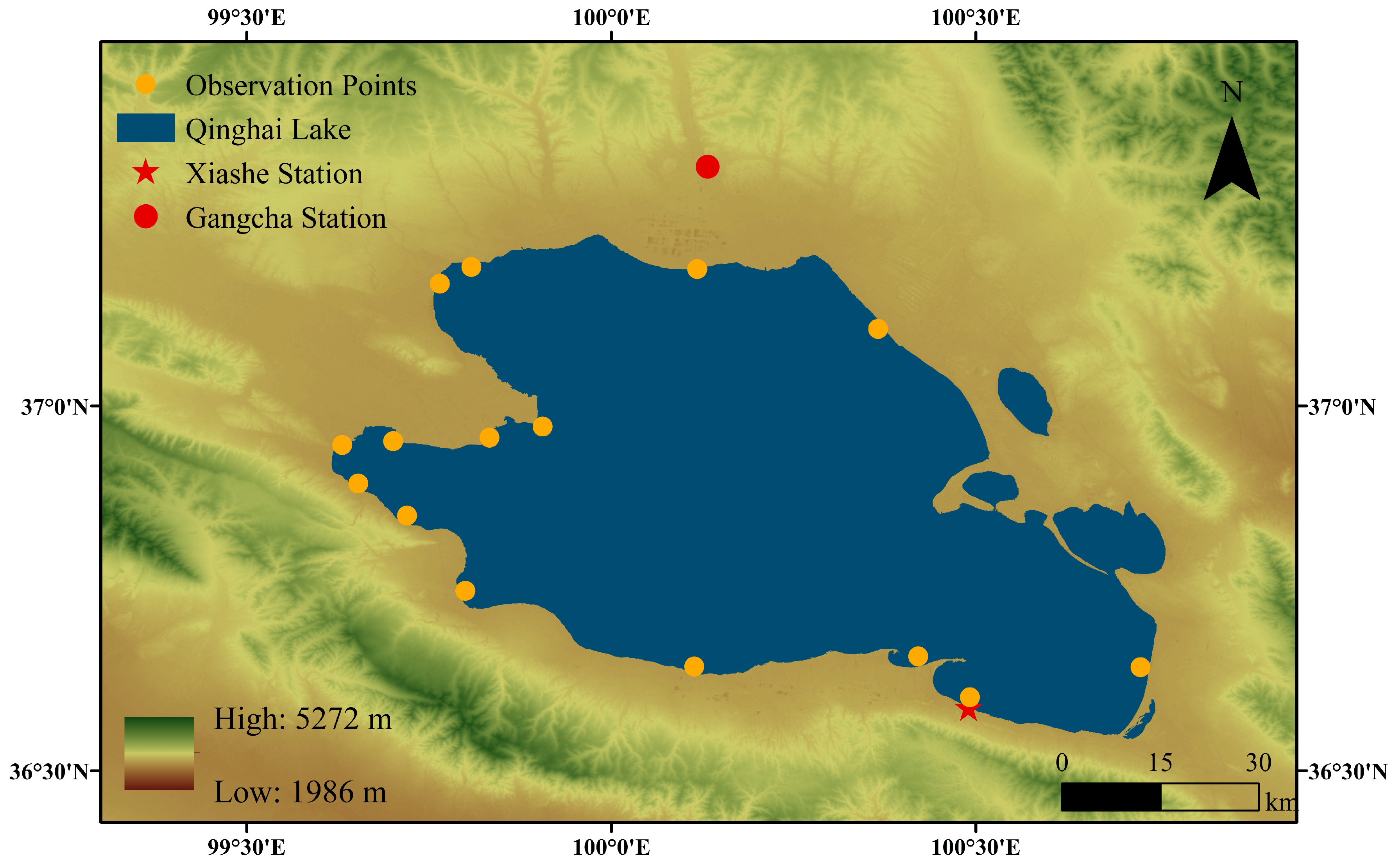
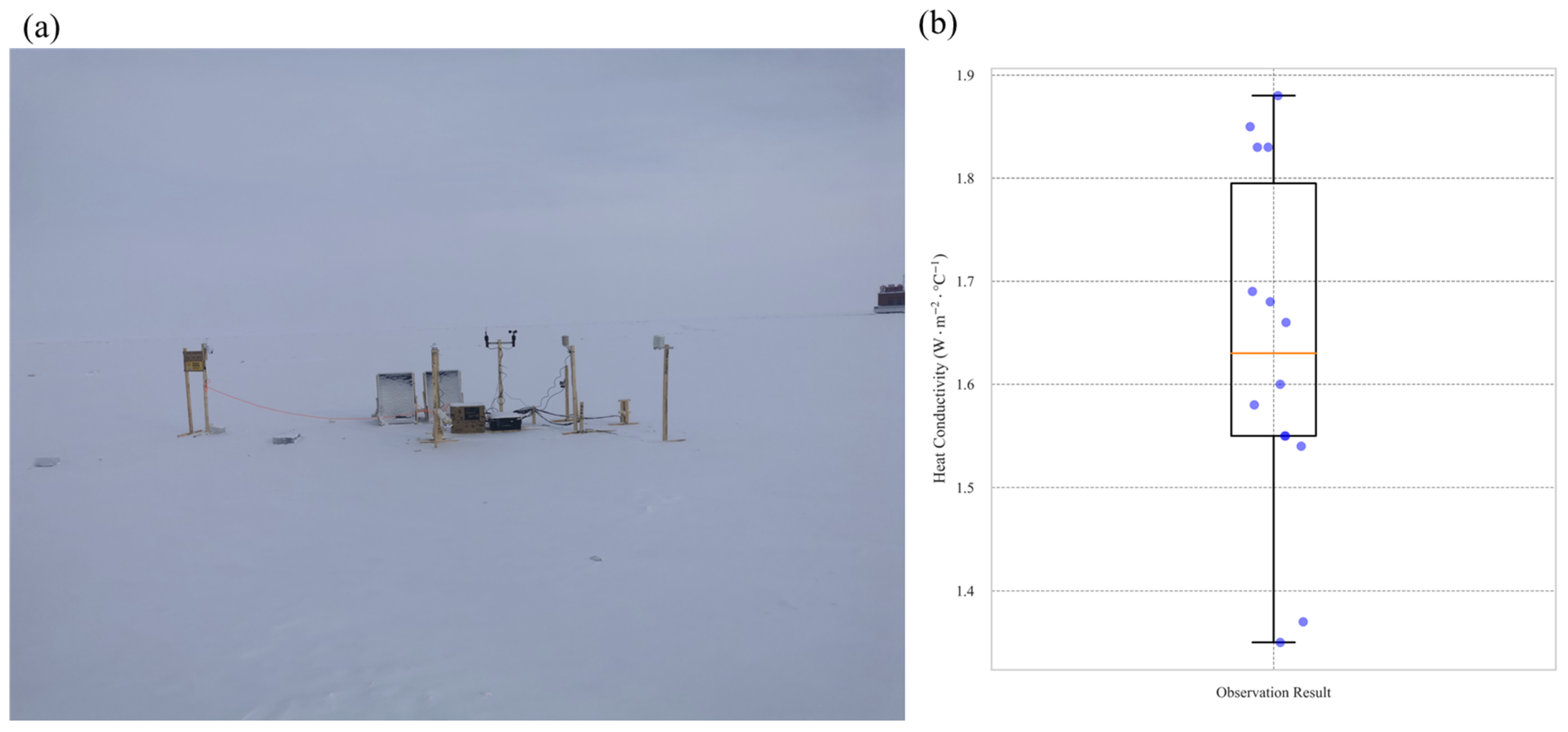
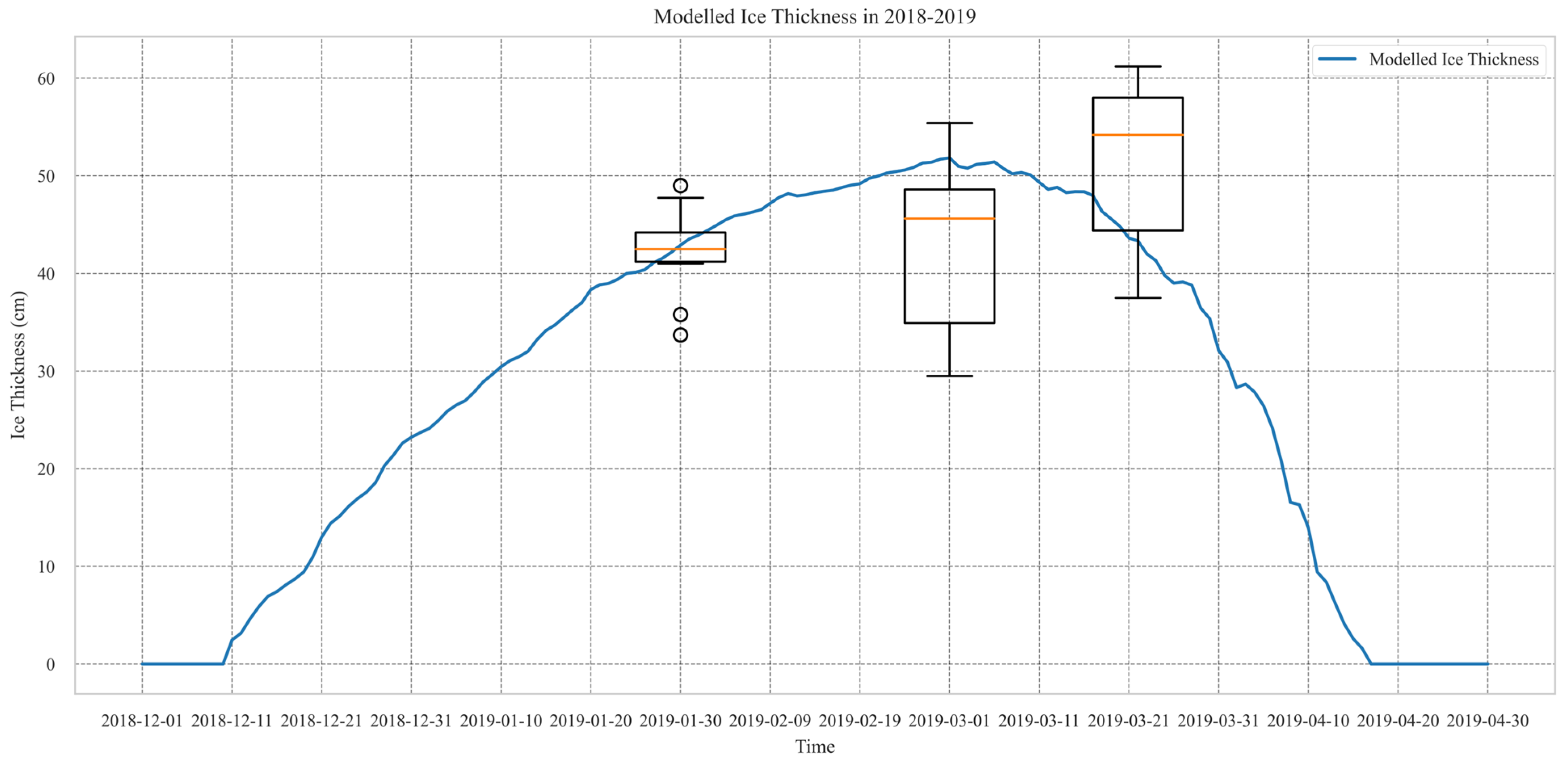

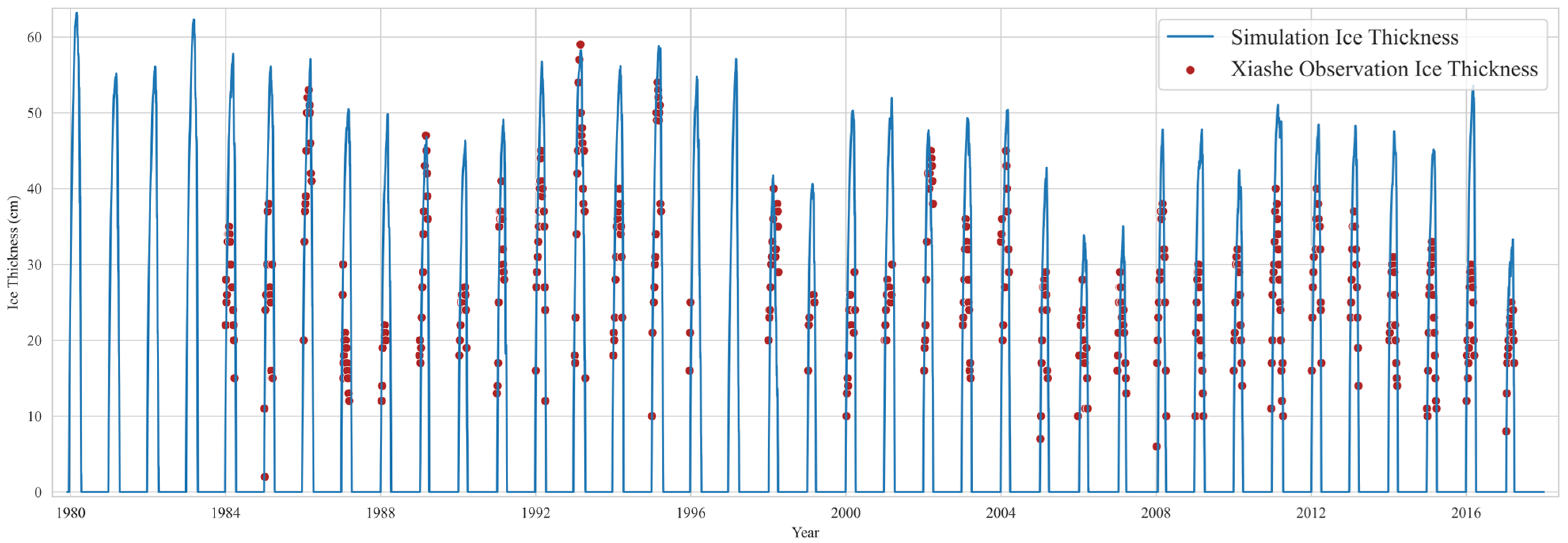
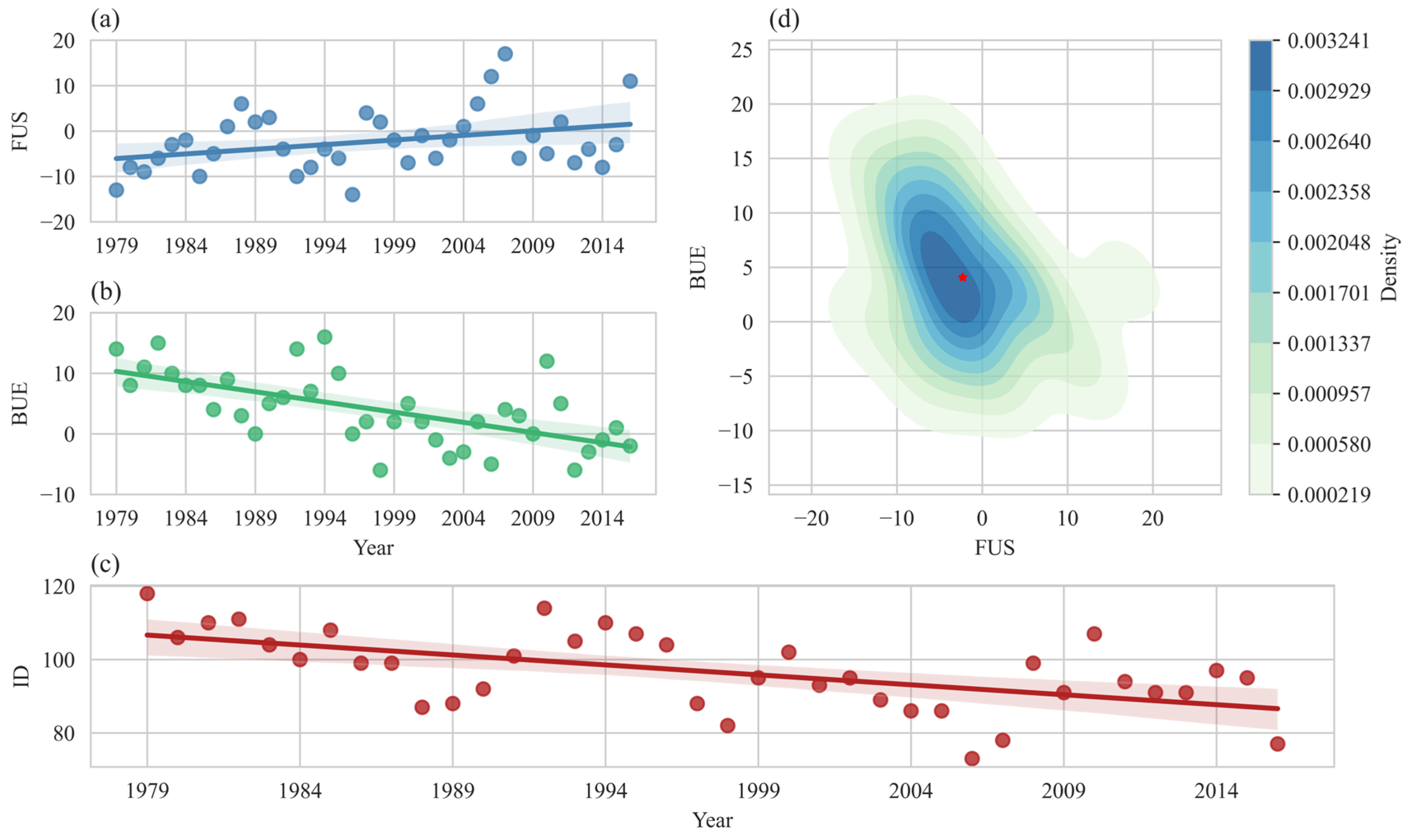
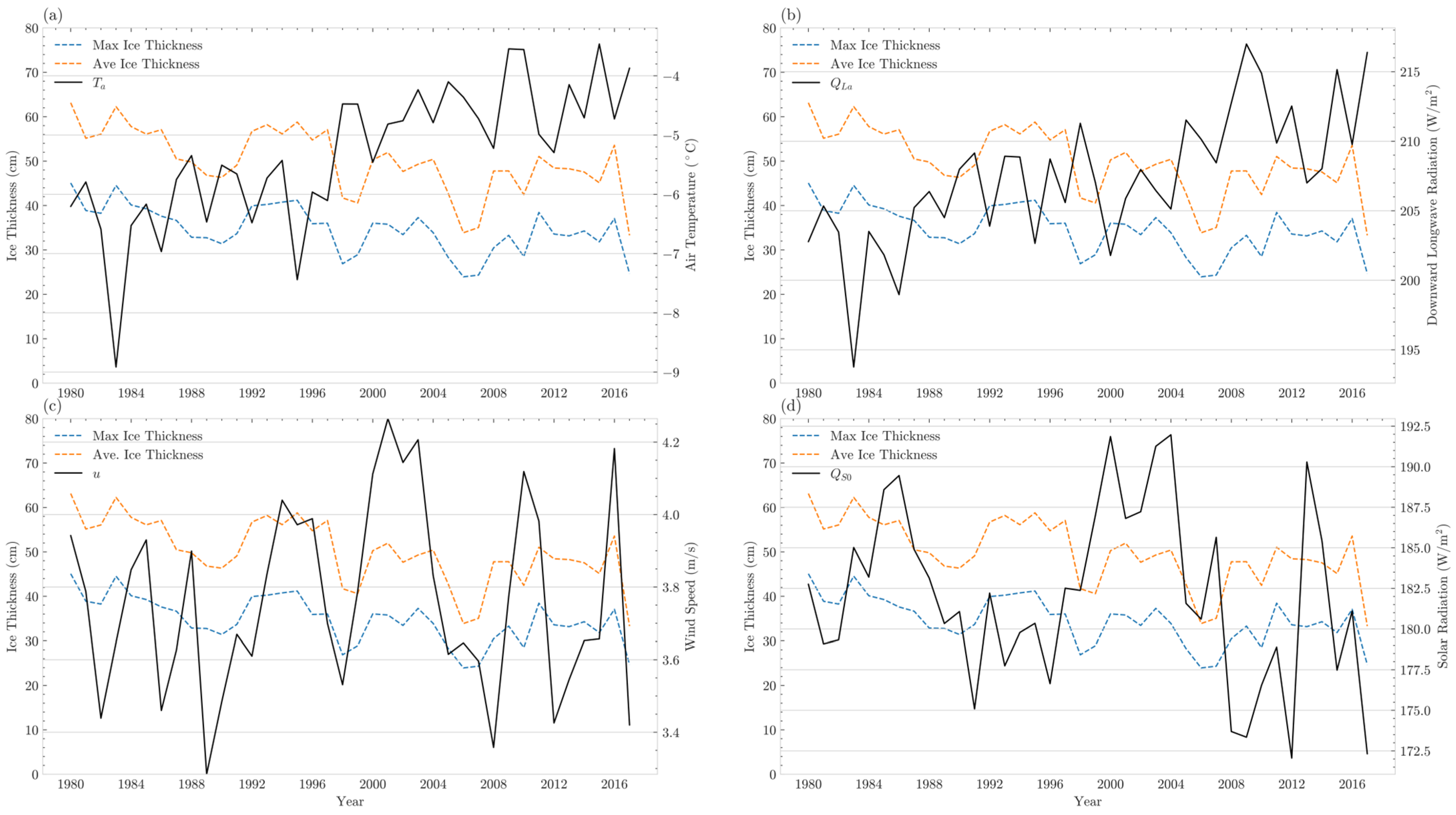
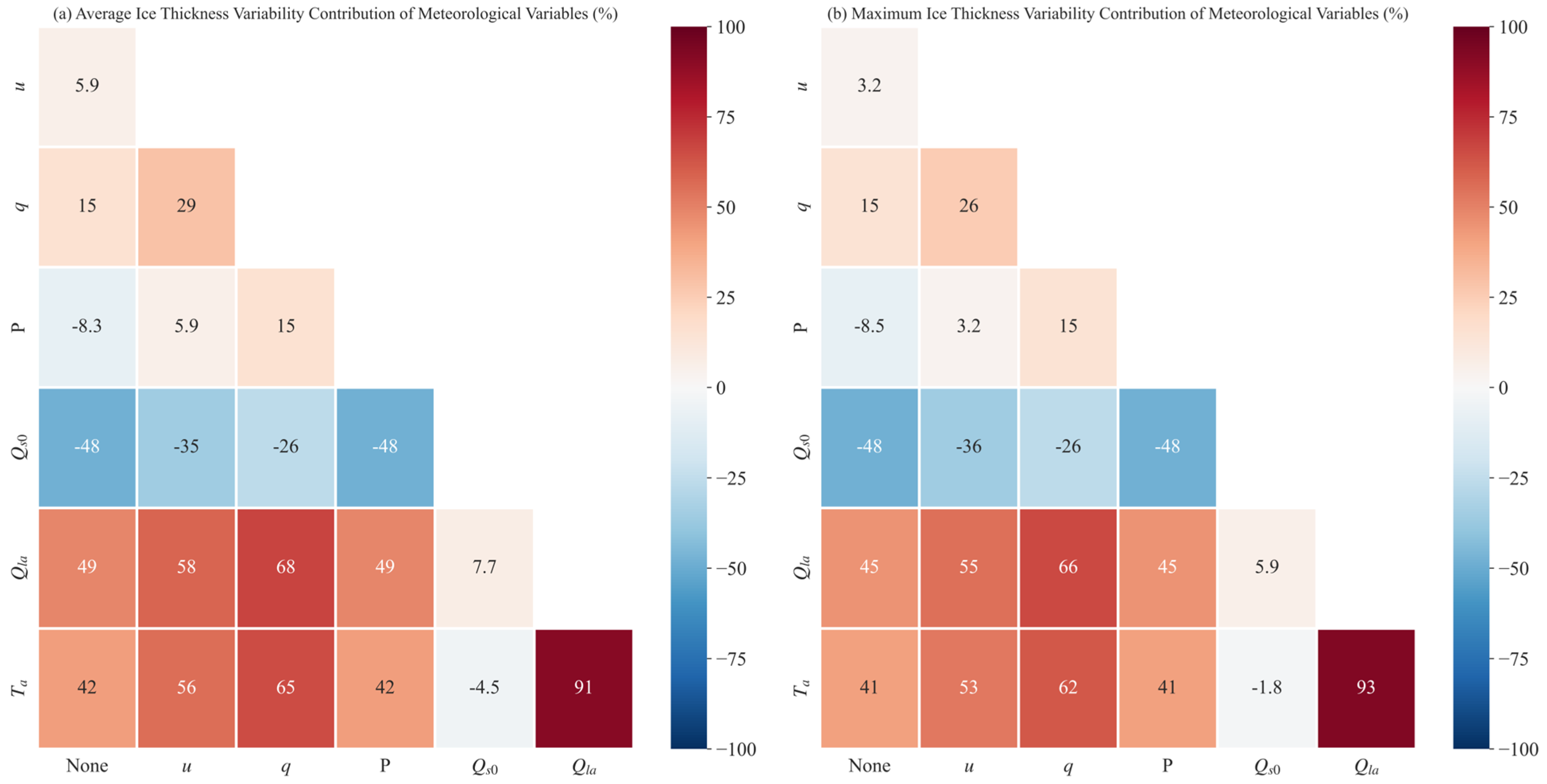
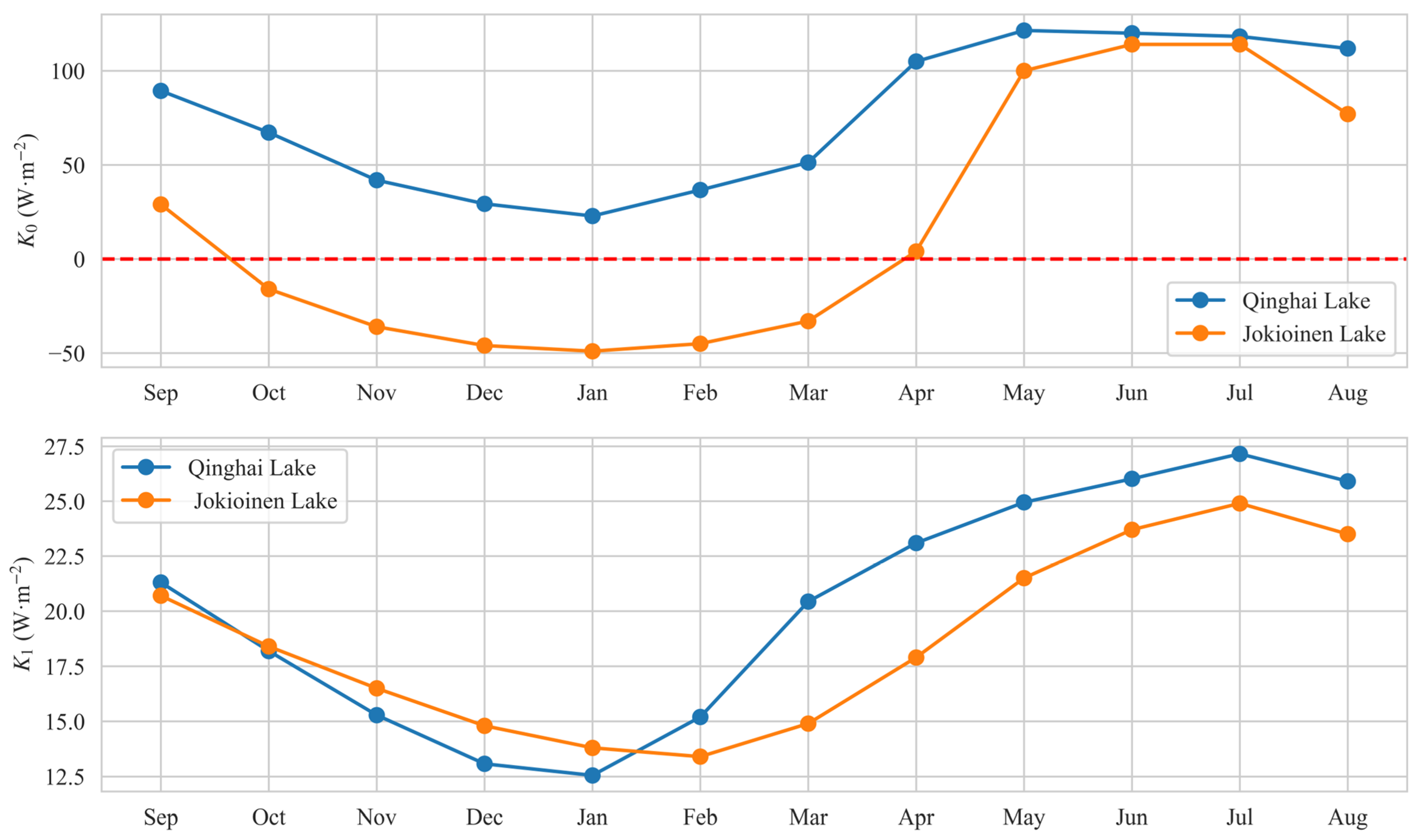
| Count | Mean | Std | Min | 25% | 50% | 75% | Max |
|---|---|---|---|---|---|---|---|
| 31 | 0.067 | 0.060 | −0.057 | 0.021 | 0.074 | 0.110 | 0.153 |
Disclaimer/Publisher’s Note: The statements, opinions and data contained in all publications are solely those of the individual author(s) and contributor(s) and not of MDPI and/or the editor(s). MDPI and/or the editor(s) disclaim responsibility for any injury to people or property resulting from any ideas, methods, instructions or products referred to in the content. |
© 2024 by the authors. Licensee MDPI, Basel, Switzerland. This article is an open access article distributed under the terms and conditions of the Creative Commons Attribution (CC BY) license (https://creativecommons.org/licenses/by/4.0/).
Share and Cite
Tang, H.; Zhao, Y.; Wen, L.; Leppäranta, M.; Niu, R.; Fu, X. Modeling Climate Characteristics of Qinghai Lake Ice in 1979–2017 by a Quasi-Steady Model. Remote Sens. 2024, 16, 1699. https://doi.org/10.3390/rs16101699
Tang H, Zhao Y, Wen L, Leppäranta M, Niu R, Fu X. Modeling Climate Characteristics of Qinghai Lake Ice in 1979–2017 by a Quasi-Steady Model. Remote Sensing. 2024; 16(10):1699. https://doi.org/10.3390/rs16101699
Chicago/Turabian StyleTang, Hong, Yixin Zhao, Lijuan Wen, Matti Leppäranta, Ruijia Niu, and Xiang Fu. 2024. "Modeling Climate Characteristics of Qinghai Lake Ice in 1979–2017 by a Quasi-Steady Model" Remote Sensing 16, no. 10: 1699. https://doi.org/10.3390/rs16101699





